Newsletter September 2013: Tunisian crochet: adding spaceNews:For the knitters, EclatDuSoleil presents Pointue. Pointue is worked from side to side in fingering weight merino. The border is knitted at the same time as the body of the shawl, and is shaped with short rows.More information in the shop.For crocheters and knitters alike, I have received new alpaca yarns, both fingering and laceweight.
Pointue is worked from side to side in fingering weight merino. The border is knitted at the same time as the body of the shawl, and is shaped with short rows.More information in the shop.For crocheters and knitters alike, I have received new alpaca yarns, both fingering and laceweight. Do check out the new colours, particularly for the laceweight alpaca.More information in the shop.I have also introduced a locally produced yarn, the French merino DK. It comes from sheep bred in the French Alps, and has been spun just on the other side of the mountains, in northern Italy.
Do check out the new colours, particularly for the laceweight alpaca.More information in the shop.I have also introduced a locally produced yarn, the French merino DK. It comes from sheep bred in the French Alps, and has been spun just on the other side of the mountains, in northern Italy. This super soft yarn from the sheep breed Mérinos d’Arles is available in four colours.More information in the shop.Tunisian crochet, adding spaceOn the topic of Tunisian crochet, I have already discussed the basics (in May 2009), working in the round (in May 2013) and reversible Tunisian crochet (in March 2013). On all these occasions, I used the simple Tunisian stitch. It’s the best-known stitch, and it yields a firm and solid fabric.However, I came to understand that Tunisian crochet could be different from this. I had seen airy shawls worked in this technique, so I knew the solid, sturdy fabric that made such nice potholders and phone covers was not the only one you could obtain.So, what you need to add to traditional Tunisian crochet to get another look is – space. Space in the shape of taller stitches, and space in the shape of holes, to create the possibility of openwork.First, the taller stitches. Let’s look at how to make a Tunisian double crochet (Tdc). I am going to work into a base row of Tunisian simple stitch, but you can, of course, start working Tdc directly into the starting chain.At the beginning of the row, chain 1 to compensate for the stitch height.
This super soft yarn from the sheep breed Mérinos d’Arles is available in four colours.More information in the shop.Tunisian crochet, adding spaceOn the topic of Tunisian crochet, I have already discussed the basics (in May 2009), working in the round (in May 2013) and reversible Tunisian crochet (in March 2013). On all these occasions, I used the simple Tunisian stitch. It’s the best-known stitch, and it yields a firm and solid fabric.However, I came to understand that Tunisian crochet could be different from this. I had seen airy shawls worked in this technique, so I knew the solid, sturdy fabric that made such nice potholders and phone covers was not the only one you could obtain.So, what you need to add to traditional Tunisian crochet to get another look is – space. Space in the shape of taller stitches, and space in the shape of holes, to create the possibility of openwork.First, the taller stitches. Let’s look at how to make a Tunisian double crochet (Tdc). I am going to work into a base row of Tunisian simple stitch, but you can, of course, start working Tdc directly into the starting chain.At the beginning of the row, chain 1 to compensate for the stitch height.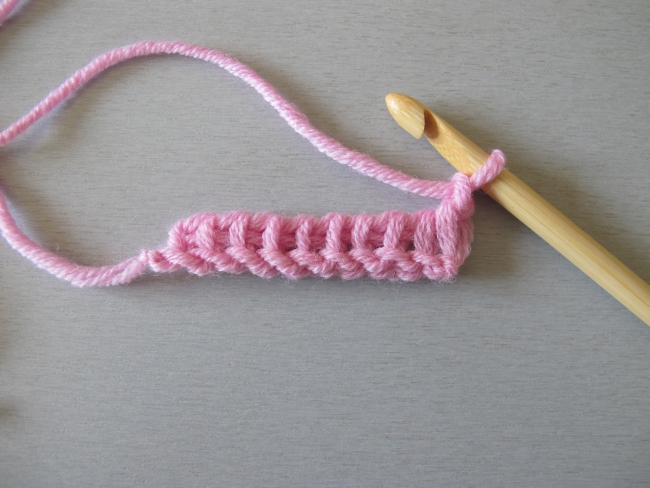 Yarn over and insert hook under the vertical bar of the second stitch in the row.
Yarn over and insert hook under the vertical bar of the second stitch in the row.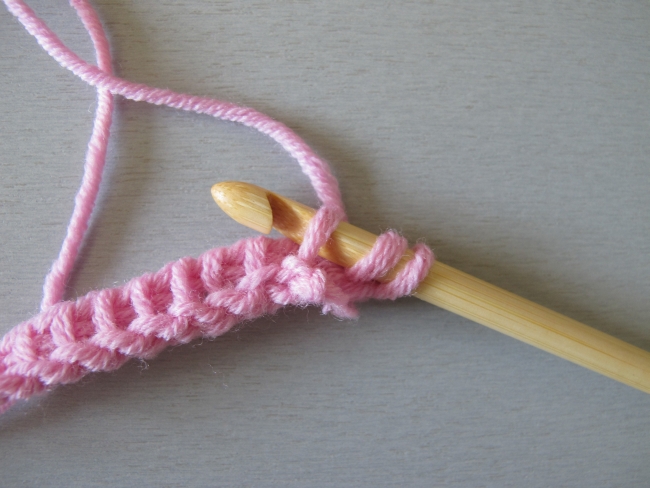 Yarn over and pull through. You now have 3 loops on the hook. You will recognize the corresponding step in an ordinary double crochet.
Yarn over and pull through. You now have 3 loops on the hook. You will recognize the corresponding step in an ordinary double crochet.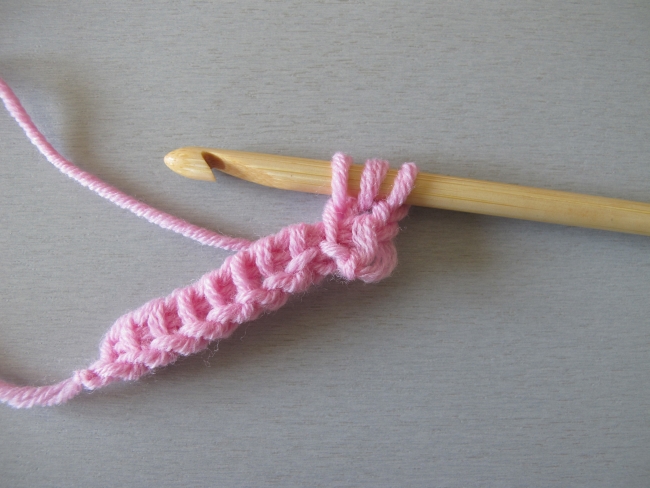 Yarn over, pull through two loops on the hook and stop there. You have finished the part of the Tdc that is done on the forward pass.
Yarn over, pull through two loops on the hook and stop there. You have finished the part of the Tdc that is done on the forward pass.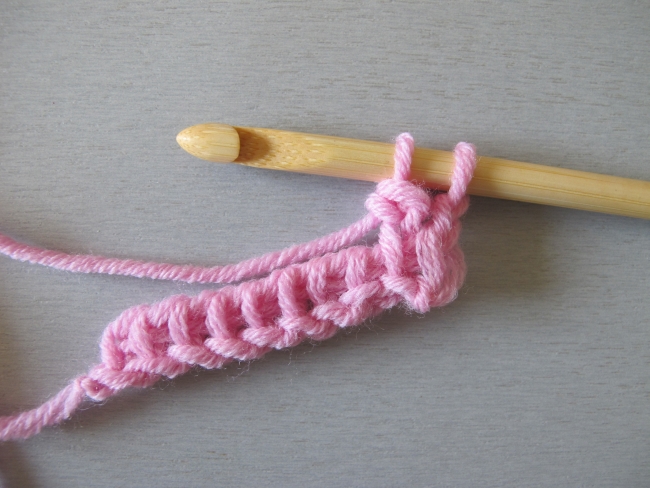 Repeat for each stitch in the row until you have worked all stitches and the number of loops on your hook is equal to the number of stitches in your row.
Repeat for each stitch in the row until you have worked all stitches and the number of loops on your hook is equal to the number of stitches in your row.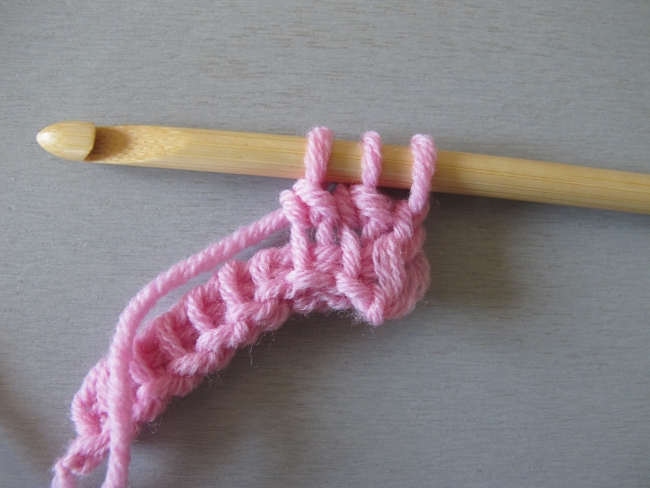
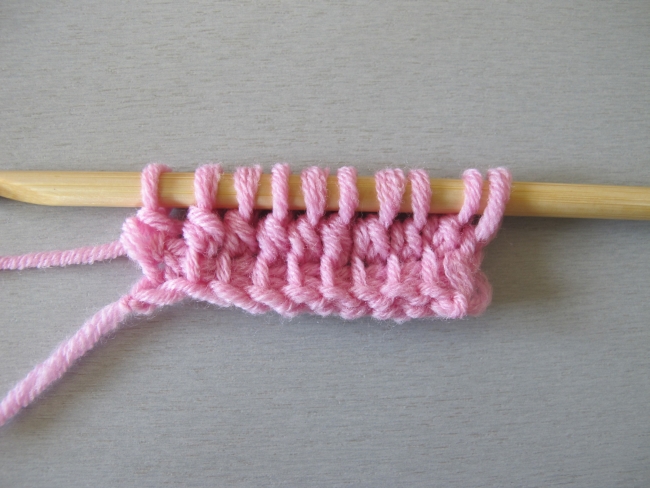 Work the backward pass as usual (yo, pull through 1 loop, repeat [yo, pull through 2 loops] to the end of the row.)
Work the backward pass as usual (yo, pull through 1 loop, repeat [yo, pull through 2 loops] to the end of the row.)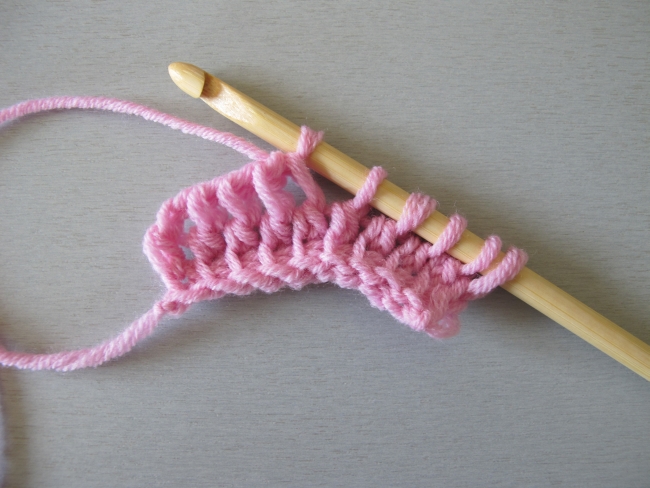
 Continue to desired height. In the pictures, you can very clearly see the bottom of the stitch, looking like the bottom part of any dc, and the top of the stitch with the chain created by the backward pass running through it.
Continue to desired height. In the pictures, you can very clearly see the bottom of the stitch, looking like the bottom part of any dc, and the top of the stitch with the chain created by the backward pass running through it.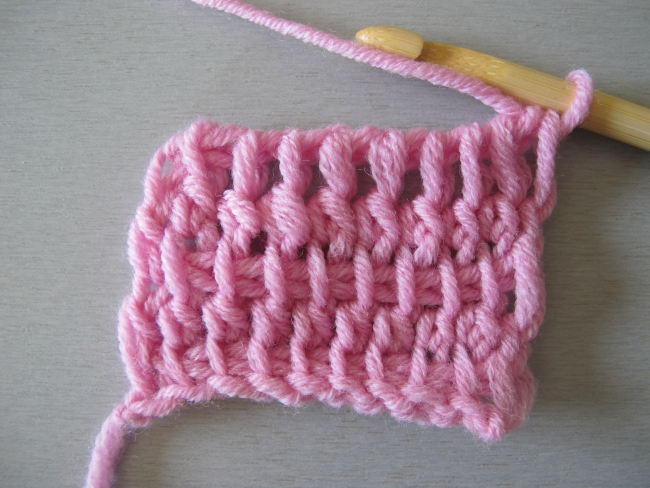
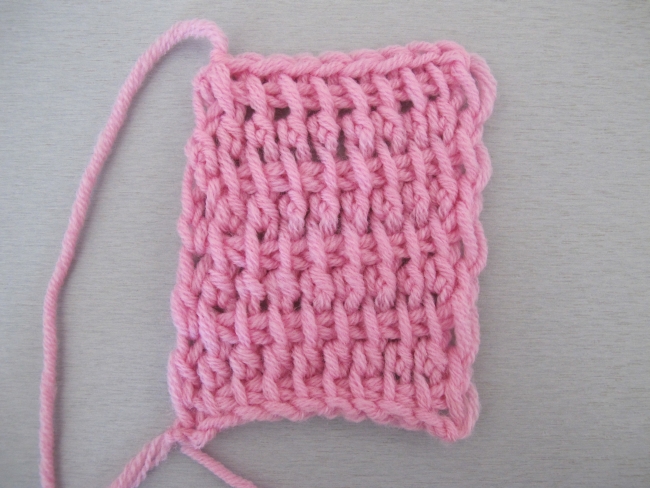 It is interesting to note that the Tdc’s add quite a lot of height, and that this swatch in Tdc lies very flat compared to a swatch in Tunisian simple stitch (Tss).Also, when working Tdc, I realized that the Tss is really a Tunisian single crochet. Following the same logic, you can substitute any traditional crochet stitch, working it until only the last « yo and pull through » remains. The last step of the stitch will be accomplished on the return pass.So, that’s space in the shape of taller stitches. But real space? Holes? How can we make those?Here I’m starting again with a row of Tdc at the bottom of the swatch. Now, I want to do openwork.The loop on my hook is the first stitch. I yarn over. This yarnover will replace the second stitch in the row. This means I will skip the second stitch in the previous row.
It is interesting to note that the Tdc’s add quite a lot of height, and that this swatch in Tdc lies very flat compared to a swatch in Tunisian simple stitch (Tss).Also, when working Tdc, I realized that the Tss is really a Tunisian single crochet. Following the same logic, you can substitute any traditional crochet stitch, working it until only the last « yo and pull through » remains. The last step of the stitch will be accomplished on the return pass.So, that’s space in the shape of taller stitches. But real space? Holes? How can we make those?Here I’m starting again with a row of Tdc at the bottom of the swatch. Now, I want to do openwork.The loop on my hook is the first stitch. I yarn over. This yarnover will replace the second stitch in the row. This means I will skip the second stitch in the previous row. I start the next Tdc by making a yarnover and inserting the hook under the third vertical bar.
I start the next Tdc by making a yarnover and inserting the hook under the third vertical bar. I finish the Tdc. The first yarnover remains on the hook, in the place of the second stitch of the row.
I finish the Tdc. The first yarnover remains on the hook, in the place of the second stitch of the row.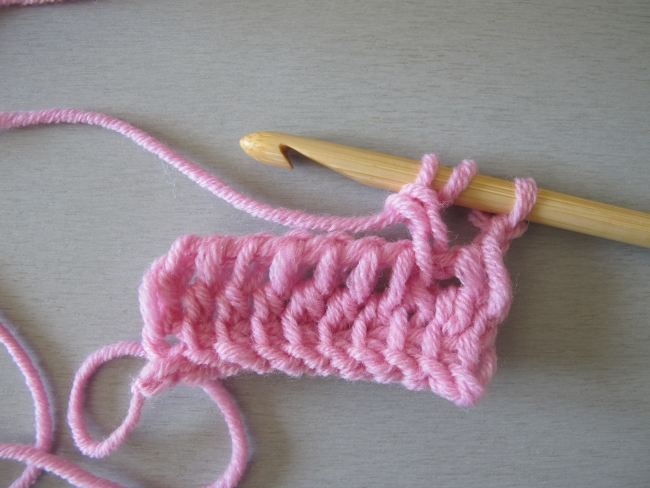 I continue by skipping every second stitch, replacing it with a yarnover. (The number of stitches is even, so the row finishes with 2 Tdc). Note that the loops coming out of the Tdc’s and the loops created by the yarnovers look different (the yarnovers slant). This doesn’t matter in the stitch count – each loop counts as a stitch, and will be worked off as usual on the backward pass.
I continue by skipping every second stitch, replacing it with a yarnover. (The number of stitches is even, so the row finishes with 2 Tdc). Note that the loops coming out of the Tdc’s and the loops created by the yarnovers look different (the yarnovers slant). This doesn’t matter in the stitch count – each loop counts as a stitch, and will be worked off as usual on the backward pass.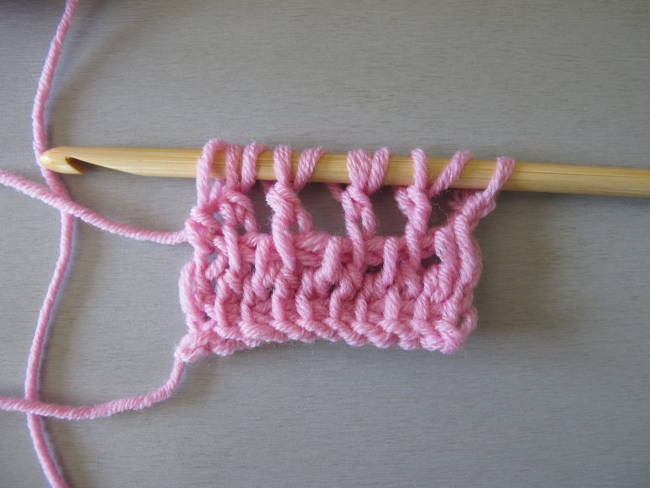 The backward pass is finished. It is important to distinguish between the loops coming out of the stitches (left arrow) and the yarnovers (right arrow). There are many different ways of inserting your hook in Tunisian crochet, and the instructions for a forward pass after an openwork row can vary. You need to understand the « anatomy » of the row in order to work the next one correctly.
The backward pass is finished. It is important to distinguish between the loops coming out of the stitches (left arrow) and the yarnovers (right arrow). There are many different ways of inserting your hook in Tunisian crochet, and the instructions for a forward pass after an openwork row can vary. You need to understand the « anatomy » of the row in order to work the next one correctly. Here, however, we are doing nothing complicated. We are just going to offset the next row, working Tdc’s in the open spaces (simply inserting the hook in the space itself, between two Tdc’s in the previous row), and creating space with yarnovers over the Tdc’s that will be skipped.Note that the way the following row is worked has a lot of impact on the look of the row below. Here you can clearly see that the last openwork row is less elongated than the other ones, because the stitches in the next row are worked also into the Tdc’s and not only in the open spaces.
Here, however, we are doing nothing complicated. We are just going to offset the next row, working Tdc’s in the open spaces (simply inserting the hook in the space itself, between two Tdc’s in the previous row), and creating space with yarnovers over the Tdc’s that will be skipped.Note that the way the following row is worked has a lot of impact on the look of the row below. Here you can clearly see that the last openwork row is less elongated than the other ones, because the stitches in the next row are worked also into the Tdc’s and not only in the open spaces. I couldn’t sign off without trying yarnovers in combination with Tunisian simple stitch. Here, the open spaces are aligned on top of each other. I think the look is rather nice!
I couldn’t sign off without trying yarnovers in combination with Tunisian simple stitch. Here, the open spaces are aligned on top of each other. I think the look is rather nice!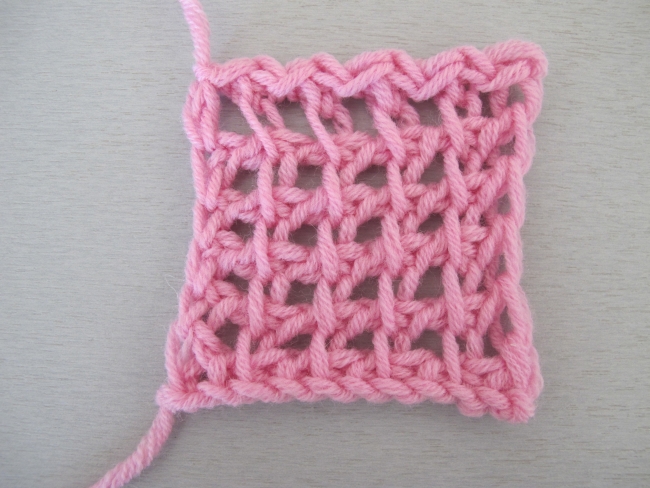 These are, of course, only the basics of working with taller stitches and yarnovers. But now you know enough to experiment on your own!All swatches in this newsletter were worked in French merino DK
These are, of course, only the basics of working with taller stitches and yarnovers. But now you know enough to experiment on your own!All swatches in this newsletter were worked in French merino DK
with a 6 mm hook.See you soon!

